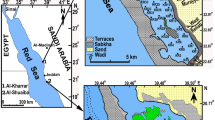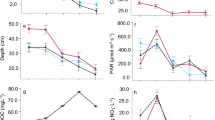Abstract
A biological survey was carried out in 640 stations spread over the Loire-Bretagne National Network (France) between 1996 and 2000. Epilithic diatom inventories were obtained following standard methods. A total of 934 diatom taxa were identified. Common diversity indices (species richness, Shannon’s diversity, equitability, dominance, etc.) were calculated and compared against abiotic factors verify their reliability as biomonitoring metrics. Sampling stations were classified according to their trophic status (TP concentration). Several theoretical predictions about the relationship between community structural parameters and limnological variables were tested. In general, diversity indices exhibited poor linear correlations with environmental factors indicating ecological status. No clear patterns were found concerning species accumulation curves, occurrence-abundance, frequency-abundance and frequency distribution of diatom taxa between different trophic levels, although assemblages from stations with lower TP levels were characterized by relatively high dominances of certain taxa, mainly Achnanthidium minutissimum. In the light of these findings, the use of diatom diversity indices in biological quality surveillance protocols in continental waters is discouraged. Results are compared and discussed with similar studies.





Similar content being viewed by others
References
APHA, 1995. Standard Methods for the Examination of Water and Wastewater. APHA, Washington.
Archibald, R. E. M., 1972. Diversity in some South African diatom associations and its relation to water quality. Water Research 6: 1229–1238.
Bellinger, B. J., C. Cocquyt & C. M. O’Reilly, 2006. Benthic diatoms as indicators of eutrophication in tropical streams. Hydrobiologia 573: 75–87.
Bergfur, J., 2007. Ecological Integrity of Boreal Streams. Assessing Impacts on Community Structure and Function. Doctoral thesis. Swedish University of Agricultural Sciences, Uppsala. Acta Universitatis Agriculturae Sueciae 50: 39 pp. http://bit.ly/IDohoG.
Blanco, S., E. Bécares, H.-M. Cauchie, L. Hoffmann & L. Ector, 2007. Comparison of biotic indices for water quality diagnosis in the Duero Basin (Spain). In Ács, É., K. T. Kiss & J. Padisák (eds), Proceedings of 6th International Symposium on Use of Algae for Monitoring Rivers, Hungary, Balatonfüred, 12–16 Sept. 2006. Archiv für Hydrobiologie Supplement 161, Large Rivers 17: 267–286.
Bonn, A., D. Storch & K. J. Gaston, 2004. Structure of the species-energy relationship. Proceedings of the Royal Society of London B 271: 1685–1691.
Canning-Clode, J., M. Kaufmann, M. Molis, M. Wahl & M. Lenz, 2008. Influence of disturbance and nutrient enrichment on early successional fouling communities in an oligotrophic marine system. Marine Ecology 29: 115–124.
Chase, J. M. & M. A. Leibold, 2002. Spatial scale dictates the productivity-biodiversity relationship. Nature 416: 427–430.
Cox, S. B., C. P. Bloch, R. D. Stevens & L. F. Huenneke, 2006. Productivity and species richness in an arid ecosystem: a long-term perspective. Plant Ecology 186: 1–12.
de la Rey, P. A., L. van Rensburg & A. Vosloo, 2008. On the use of diatom-based biological monitoring. Part 1: a comparison of the response of diversity and aut-ecological diatom indices to water quality variables in the Marico-Molopo River catchment. Water SA 34: 53–60.
Di Dato, P., F. Rimet, L. Tudesque, L. Ector & M. Scardi, 2005. Use of neural network models to predict diatom assemblages in the Loire-Bretagne basin (France). In Lek, S., M. Scardi, P. F. M. Verdonschot, J.-P. Descy & Y.-S. Park (eds), Modelling Community Structure in Freshwater Ecosystems. Springer, Berlin: 355–365.
Drake, J. M., D. M. Lodge & C. Costello, 2008. Response. Ecological Applications 18: 1323–1324.
Ector, L. & F. Rimet, 2005. Using bioindicators to assess rivers in Europe: an overview. In Lek, S., M. Scardi, P. F. M. Verdonschot, J.-P. Descy & Y.-S. Park (eds), Modelling Community Structure in Freshwater Ecosystems. Springer, Berlin: 7–19.
Foerster, J., A. Gutowski & J. Schaumburg, 2004. Defining types of running waters in Germany using benthic algae: a prerequisite for monitoring according to the Water Framework Directive. Journal of Applied Phycology 16: 407–418.
Foody, G. M., 2004. Spatial nonstationarity and scale-dependency in the relationship between species richness and environmental determinants for the sub-Saharan endemic avifauna. Global Ecology and Biogeography 13: 315–320.
Gillman, L. N. & S. D. Wright, 2006. The influence of productivity on the species richness of plants: a critical assessment. Ecology 87: 1234–1243.
Grace, J. B., T. M. Anderson, M. D. Smith, E. Seabloom, S. J. Andelman, G. Meche, E. Weiher, L. K. Allain, H. Jutila, M. Sankaran, J. Knops, M. Ritchie & M. R. Willig, 2007. Does species diversity limit productivity in natural grassland communities? Ecology Letters 10: 680–689.
Hammer, Ø., D. A. T. Harper & P. D. Ryan, 2007. PAST PAlaeontological STatistics, ver. 1.66. http://folk.uio.no/ohammer/past/.
Harrison, S., H. D. Safford, J. B. Grace, J. H. Viers & K. F. Davies, 2006. Regional and local species richness in an insular environment: serpentine plants in California. Ecological Monographs 76: 41–56.
Heino, J. & J. Soininen, 2006. Regional occupancy in unicellular eukaryotes: a reflection of niche breadth, habitat availability or size-related dispersal capacity? Freshwater Biology 51: 672–685.
John, J., 2003. Bioassessment on health of aquatic systems by the use of diatoms. In Ambasht, R. S. & N. K. Ambasht (eds), Modern Trends in Applied Aquatic Ecology. Kluwer Academic Publications, New York: 1–20.
Kelly, M. & A. Lewis, 1996. Assessing the quality of water quality assessments: an analytical quality control protocol for benthic diatoms. Freshwater Forum 7: 23–32.
Krammer, K. & H. Lange-Bertalot, 1986–1991. Bacillariophyceae 1. Teil: Naviculaceae, 876 pp.; 2. Teil: Bacillariaceae, Epithemiaceae, Surirellaceae, 596 pp.; 3. Teil: Centrales, Fragilariaceae, Eunotiaceae, 576 pp.; 4. Teil: Achnanthaceae. Kritische Ergänzungen zu Navicula (Lineolatae) und Gomphonema, 437 pp. In Ettl, H., J. Gerloff, H. Heynig & D. Mollenhauer (eds), Süßwasserflora von Mitteleuropa Band 2/1-4. G. Fischer Verlag, Stuttgart.
Lavoie, I., S. Campeau, F. Darchambeau, G. Cabana & P. J. Dillon, 2008. Are diatoms good integrators of temporal variability in stream water quality? Freshwater Biology 53: 827–841.
Magurran, A. E., 2004. Measuring Biological Diversity. Blackwell Publishing, Oxford.
Marcus, M. D., 1980. Periphytic community response to chronic nutrient enrichment by a reservoir discharge. Ecology 61: 387–399.
Mittelbach, G. G., C. F. Steiner, S. M. Scheiner, K. L. Gross, H. L. Reynolds, R. B. Waide, M. R. Willig, S. I. Dodson & L. Gough, 2001. What is the observed relationship between species richness and productivity? Ecology 82: 2381–2396.
Molis, M., 2002. Shallow Water Fouling Assemblages Exposed to Abiotic Disturbance & Stress: the Structuring Role of Emersion and UV-Radiation. Ph.D. thesis, Christian-Albrechts-Universität, Kiel. http://d-nb.info/972096310/34.
Moré, J. J., 1977. The Levenberg-Marquardt algorithm: implementation and theory. Lecture Notes in Mathematics 630: 105–116.
Moss, B., 1973. Diversity in fresh-water phytoplankton. American Midland Naturalist 90: 341–355.
Ndiritu, G. G., N. N. Gichuki & L. Triest, 2006. Distribution of epilithic diatoms in response to environmental conditions in an urban tropical stream, Central Kenya. Biodiversity and Conservation 15: 3267–3293.
Ní Chatháin, B. & T. J. Harrington, 2008. Benthic diatoms of the River Deel: diversity and community structure. Biology and Environment: Proceedings of the Royal Irish Academy 108B: 29–42.
Patrick, R., 1973. Use of algae, especially diatoms, in the assessment of water quality. In Cairns, J. Jr. & K. L. Dickson (eds), Biological Methods for the Assessment of Water Quality. A symposium presented at the Seventy-fifth Annual Meeting American Society for Testing and Materials. ASTM, Philadelphia, Special Technical Publication 528: 76–95.
Simkhada, B., I. Jüttner & P. J. Chimonides, 2006. Diatoms in lowland ponds of Koshi Tappu, eastern Nepal – relationships with chemical and habitat characteristics. International Review of Hydrobiology 91: 574–593.
Soininen, J., 2009. Is diatom diversity driven by productivity in boreal streams? Diatom Research 24: 197–207.
Soininen, J. & J. Heino, 2005. Relationships between local population persistence, local abundance and regional occupancy of species: distribution patterns of diatoms in boreal streams. Journal of Biogeography 32: 1971–1978.
StatSoft Inc., 2008. STATISTICA (data analysis software system), version 8.0. www.statsoft.com.
Vilbaste, S. & J. Truu, 2003. Distribution of benthic diatoms in relation to environmental variables in lowland streams. Hydrobiologia 493: 81–93.
Vyverman, W., E. Verleyen, K. Sabbe, K. Vanhoutte, M. Sterken, D. A. Hodgson, D. G. Mann, S. Juggins, B. Van de Vijver, V. Jones, R. Flower, D. Roberts, V. A. Chepurnov, C. Kilroy, P. Vanormelingen & A. De Wever, 2007. Historical processes constrain patterns in global diatom diversity. Ecology 88: 1924–1931.
Waide, R. B., M. R. Willig, C. F. Steiner, G. Mittelbach, L. Gough, S. I. Dodson, G. P. Juday & R. Parmenter, 1999. The relationship between productivity and species richness. Annual Review of Ecology and Systematics 30: 257–300.
Wan Maznah, W. O. & M. Mansor, 2002. Aquatic pollution assessment based on attached diatom communities in the Pinang River Basin, Malaysia. Hydrobiologia 487: 229–241.
Wu, J.-T. & L.-T. Kow, 2002. Applicability of a generic index for diatom assemblages to monitor pollution in the tropical River Tsanwun, Taiwan. Journal of Applied Phycology 14: 63–69.
Acknowledgments
The authors thank J. Durocher of the Loire-Bretagne Water Agency, M. Leitao of the Bi-Eau society, and F. Rimet of the INRA for their valuable collaboration for the elaboration of the database. Prof. E. Lobo (UNISC, Brazil) and two anonymous referees kindly revised the manuscript.
Author information
Authors and Affiliations
Corresponding author
Additional information
Guest editors: L. Ector, D. Hlúbiková & L. Hoffmann / Proceedings of the 7th International Symposium “Use of Algae for Monitoring Rivers”, Luxembourg, November 23–25, 2009
Rights and permissions
About this article
Cite this article
Blanco, S., Cejudo-Figueiras, C., Tudesque, L. et al. Are diatom diversity indices reliable monitoring metrics?. Hydrobiologia 695, 199–206 (2012). https://doi.org/10.1007/s10750-012-1113-1
Received:
Accepted:
Published:
Issue Date:
DOI: https://doi.org/10.1007/s10750-012-1113-1




